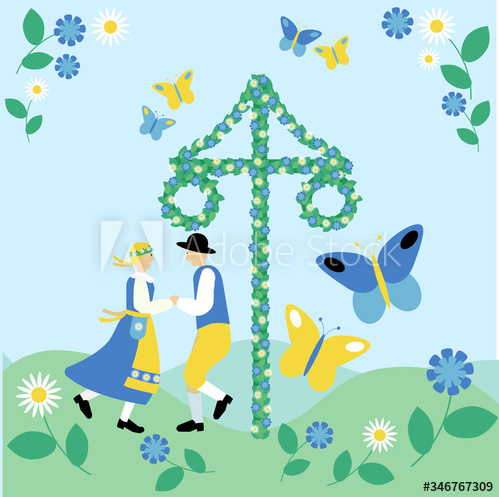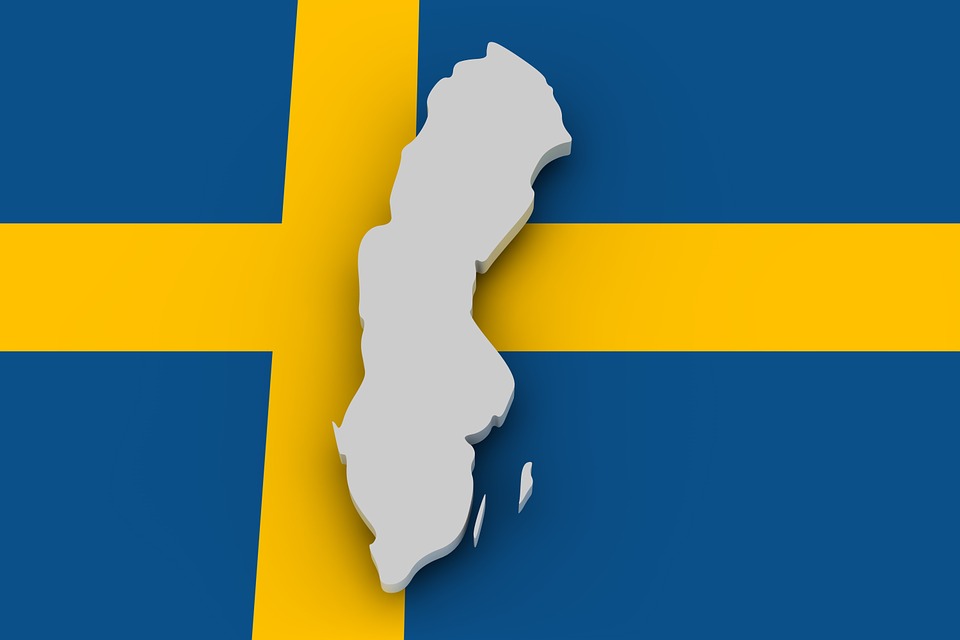In the middle of June, the schools are finally over and the nature has burst into life. It seems like the sun never sets and in fact, in the north of Sweden it doesn’t, and in the south, where I live, only for an hour or two. Swedes call it Midsummer and it calls for celebration!

So why do Swedes celebrate the Midsummer?
Swedes are fairly well attuned to the rhythms of nature. At Midsummer, many begin their five-week annual holidays and everyone is in a hurry to get things done during the relatively short summer season. Midsummer Eve is usually celebrated in the countryside, which means that on the day before, everyone leaves town, everything closes and the city streets are suddenly spookily deserted. The country’s main thoroughfares, on the other hand, are normally packed. Queues of cars stretch away into the distance, and at the end of the road, family and friends wait among silver birches in full, shimmering bloom.
This year’s celebrations will most likely look quite different, as lrge gatherings should be avoided, according to the authorities recommendations.
Probably, not many know about its Christian origins. According to Christianity, the birthday of John the Baptist occurs the 24 June, and that’s the official explanation of why we celebrate midsummer in Sweden.
However, probably around 99% of the Swedish population doesn’t really care about the birthday of John the Baptist since most are atheists and celebrate midsummer for other reasons.
Nowadays, many celebrate Midsummer in Sweden because the summer is here and it has become a folk tradition with dancing and party. Some people also say that Midsummer eve is the longest day of the year, but that’s a truth with modification. The summer solstice occurs every year the 21 June, and Midsummer eve only occurs on that day every 7th year. Before 1953, the Midsummer celebrations always occurred on the 23 June.
Other theories include that the farmers didn’t have much to do around the country this time of the year, which led to them arranging parties. It’s uncertain if midsummer celebrations occurred in Sweden before the country adopted Christianity.
What date is Midsummer in Sweden 2020?
Swedes like the world to be well-ordered, so Midsummer Eve is always a Friday between 19 and 25 June. This year, the Midsummer Eve is on the 19 June, and the Midsummer day is the 20 June. People often begin the day by picking flowers and making wreaths to place on the maypole, which is a key component in the celebrations.
Before 1953, every Midsummer Eve was on the 23 June, men this changed so that Midsummer Eve always occur week 25 on a Friday, which means that the date will change from year to year.

Swedish Midsummer menu
So, what do Swedes eat for Midsummer? The tradition can be varied across the country, and from family to family, but a typical Midsummer menu features different kinds of pickled herring, boiled new potatoes with fresh dill, soured cream and chives. This is often followed by a grilled dish of some kind, such as spare rib or salmon, and for dessert the first strawberries of summer, with cream or Jordgubbstårta.

The traditional accompaniment is a cold beer and schnapps, preferably spiced. Every time the glasses are refilled, singing breaks out a new. Swedes like drinking songs, and the racier the better. 😀
Midsummer is an occasion invested with a certain nostalgia for many Swedes. Deep inside, they agree on what it should look like and how it should proceed. So after dinner, many people still want to go out dancing, just like in the old days. Preferably on an outdoor dance floor beside a lake as the evening mist settles and the sound of the orchestra echoes back from the rocky hills on the opposite shore.
Songs to sing while drinking schnapps on Midsummer in Sweden
“Helan Går”, “När Gäddorna får” and “Tänk om jag hade lilla nubben” are probably some of the most famous drinking songs for a Swedish Midsummer celebration. These are known as “Snapsvisa” in Swedish.
There are so many different kinds of drinking songs in Sweden, and various regional versions. Luckily for me, (who I am not totally Swedish) most Midsummer parties in Sweden will have a little paper book with the lyrics written down. Here I let you a list with the popular songs and dances for the Swedish Midsummer:
- Morsgrisar är vi allihopa (we are all mama’s boys/girls)
- Små grodorna (little frogs)
- Vi äro musikanter (we are musicians)
- Tre små gummor (three old women)
- Prästens lilla kråka (the priest’s little crow)
- Raketen (the rocket)
For a non-swede, like me, these songs and dances don’t make much sense, and to be honest, for most Swedes they probably don’t either, but these are songs that they sing and dance since they are little children, and there is no real midsummer celebration without “the little frogs” dance and song. 😀
The Midsummer Wreath
It’s a tradition that girls and women wear a midsummer wreath on midsummer eve. Most make these themselves by binding flowers and leaves around a steel thread.
It’s accepted for boys and men to wear these as well, but it’s not something that is typical or traditional when it comes to Swedish Midsummer celebrations.
There are also no rules for which flowers or leaves that one can use while making the midsummer wreath, but often some colorful and pretty summer flowers mixed with green leaves will due.

Midsummer Celebrations around the country
Almost every town and village around Sweden will have its own Midsummer celebration. Many gather in parks or green areas, but some also celebrate in their villas or summer houses with friends and families.
The Swedish Midsummer celebration is often the most highlighted party and event of the year along with New Year’s Eve.
The biggest celebration is held in Stockholm, and one of the most traditional ones happens at Skansen, but you will also find local midsummer celebrations in all of the central parks. Many locals also have summer houses in the Stockholm archipelago, so if you’re lucky, you might be invited to one of those celebrations.
The Maypole or The Midsummerpole
A Midsummer pole, also known as Maypole is believed to have German origins and came to Sweden somewhere in the Middle Ages. The name of the Maypole has nothing to do with the month of May though, it comes from an expression that you “may the pole”.
In Sweden, most people call it “Midsommarstång” which would translate into a Midsummer pole. A legend also says that the pole is believed to be an upside down phallus symbol from the Viking age, but most experts agree that this is just a myth.
Midsummer is normally an occasion of large gatherings − and to be honest, many Swedes take advantage of it to fulfil their social obligations so that they can enjoy the rest of their holiday in peace. In many cases, whole families gather to celebrate this traditional high-point of the summer.
The maypole is raised in an open spot and traditional ring-dances ensue, to the delight of the children and some of the adults. Teenagers tend to stay out of it and wait for the evening’s more riotous entertainment.

The mysterious Midsummer
On their way home, girls and young women are supposed to pick seven different species of flowers and lay them under their pillows. At night, their future husbands appear to them in a dream.

According to the legend, the night before Midsummer’s Day is a magical time for love. It still is, in a way. During that night many who are into a relationship are put to the test. Under the influence of alcohol, the truth will out, which can lead both to marriage or to divorce. 😀
Like Whitsun, Midsummer is a popular time of year for weddings and christening ceremonies. Despite their poor faith and churchgoers, Swedes still like to go in a country church with a flower-bedecked, arched entrance and beautiful hymns.
The skinny dip at night
Another tradition on a Swedish Midsummer is to end it with a skinny dip at night. It’s not mandatory to be naked, but many will be completely naked accompanied with an old or new partner after a couple of the famous schnapps.

… and here I leave you with a funny video in English about the Swedish Midsummer! Have Fun! 😀
Want to know more about the Swedish Midsummer? Leave a comment below and I’ll be happy to answer you! 🙂




https://yoga-world.org
bookmarked!!, I love your website!
Hi and thank you very much! 🙂